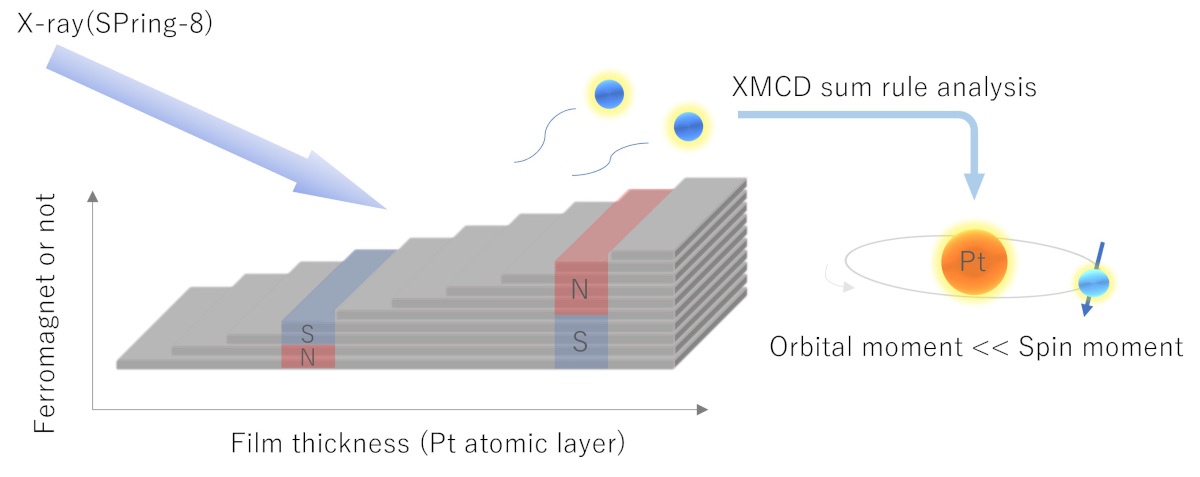Thickness-Dependent Oscillation Behavior of Magnetic Phase Transitions in Pt Ultrathin Films with Small Orbital Moment
© The Physical Society of Japan
This article is on
Appearance of Ferromagnetism in Pt(100) Ultrathin Films Originated from Quantum-well States
(JPSJ Editors' Choice)
J. Phys. Soc. Jpn.
91,
124708
(2022)
.
Ferromagnetism in nano-Pt films originates from the quantum-confinement effect that depends on film thickness. Studies of the electronic states of nano-Pt will aid in developing methods for efficiently utilizing its large spin-orbit coupling.

Spintronics, the next generation of electronics which utilizes the spin degrees of freedom, is being actively studied in recent years for developing new devices with novel properties. Pt has been an important material in this field since its inception owing to its large spin-orbit coupling.
In terms of the magnetic properties, bulk Pt is paramagnetic whereas Pt nanoparticles exhibit ferromagnetism that originates from the "finite size effect". The detailed mechanism for the appearance of ferromagnetism in Pt nanoparticles is unclear because of complex particle shapes. Thus, the electronic state of nano-Pt is non-trivial, and precise experimental studies for revealing its electronic/magnetic states using high quality nano-Pt is expected to provide important insights for developing nano-spintronic materials.
In this study, we demonstrated the successful preparation of high-quality Pt single-crystal ultrathin films and appearance of ferromagnetism in Pt ultrathin films. Magnetization measurements and density functional theory calculations indicated that ferromagnetism appeared depending on the thickness of Pt with oscillatory behavior. This suggested that the ferromagnetism of nano-Pt originated from quantum-confinement effects.
High-quality ferromagnetic Pt ultrathin films facilitate the analysis of precise electronic and magnetic properties. We investigated the spin/orbital moment of ferromagnetic Pt ultrathin films by utilizing synchrotron X-ray magnetic circular dichroism measurements at the SPring-8 beamline BL39XU. The resultant orbital magnetic moment of pure nano-Pt with large spin-orbit coupling was found to be small like that of Fe.
The present results suggested that to effectively utilize the spin-orbit coupling of Pt effectively, it is necessary to adjust the shape of its wavefunction and enhance its orbital magnetic moment by forming interfaces with other materials (namely, controlling the boundary conditions in nanostructures) and/or by applying external fields. Thus, they provide important insights into the reconsideration of the role of Pt in spintronics research.
The development of materials with well-understood physics, such as the present Pt ultrathin films, is essential for developing a principle-based R&D approach and provides fundamental information for devices. Research and development of multilayer spintronic devices is expected to be further promoted from the perspective of electronic structure based on Pt ultrathin films with well-defined electronic and magnetic states.
(Written by S. Sakuragi, MRI Research Associates, Inc., on behalf of all authors)
Appearance of Ferromagnetism in Pt(100) Ultrathin Films Originated from Quantum-well States
(JPSJ Editors' Choice)
J. Phys. Soc. Jpn.
91,
124708
(2022)
.
Share this topic
Fields
Related Articles
-
Higher-Order Topological Phases in Magnetic Materials with Breathing Pyrochlore Structures
Electronic structure and electrical properties of surfaces and nanostructures
Magnetic properties in condensed matter
Mathematical methods, classical and quantum physics, relativity, gravitation, numerical simulation, computational modeling
2025-4-7
A simple example of a higher-order topological phase, in which the symmetry decreases step-by-step from the bulk to the corner, is realized in a magnetic system with a pyrochlore structure and is characterized by a series of quantized Berry phases defined for the bulk, surface, and edge.
-
Existence of Chiral Soliton Lattices (CSLs) in Chiral Helimagnet Yb(Ni1-xCux)3Al9
Magnetic properties in condensed matter
2025-4-1
Our study examines the magnetic structure of the monoaxial chiral helimagnet Yb(Ni1-xCux)3Al9, providing first direct evidence of the formation of chiral soliton lattice state.
-
Understanding Pressure-Induced Superconductivity in CrAs and MnP
Magnetic properties in condensed matter
2025-3-10
This study reviews existing research on the pressure-induced variation of magnetic properties of transition metal mono-pnictides like CrAS, MnP, and others, aiming to understand the unconventional superconductivity observed in CrAs and MnP.
-
Symmetry and AI: Building the Future of Physics Simulations
Magnetic properties in condensed matter
Measurement, instrumentation, and techniques
2025-2-18
Generative artificial intelligence (AI) has gained considerable attention in scientific fields. By embedding physical symmetry into AI before training, we created a faster and lighter model. Scaling improves the accuracy and unlocks the potential of physics research and applications.
-
Triangular Lattice Magnet GdGa2: Spin Cycloids and Skyrmions
Cross-disciplinary physics and related areas of science and technology
Electronic transport in condensed matter
Magnetic properties in condensed matter
2025-2-3
Careful measurements were conducted on the hexagonal magnet GdGa2 to reveal the experimental signatures of ultrasmall spin cycloids and of a potential Néel-type skyrmion lattice phase induced by a magnetic field.




